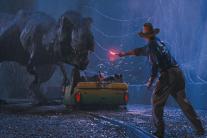Could Jurassic Park Actually Happen?
Wed, 08/30/2017 - 12:42pm(source: UL Lafayette Grad School blog -- 07/13/2017)
"Jurassic Park" - the quintessential dinosaur movie. Since its release in 1993, the film has spurred a renewed interest in paleontology and geology at college campuses across the country. Because of the movie, earning your master's in paleontology or geology became increasingly popular—and dinosaurs? They are just about the coolest thing you could study.
In the film (in case you've been living in a cave for the past 30 years), scientific advancements aided the creation of a theme park full of living dinosaurs, which were genetically engineered from insect DNA extracted from amber.
Science today can make amazing things happen, but we're not quite to the point of resurrecting dinosaurs (yet). However, the method of extracting DNA from rocks and minerals does exist and can lead us to other discoveries, including finding life on Mars.
Dr. Brian Schubert, professor in the School of Geosciences and graduate coordinator for the master's in geology program, has experience in this particular area. For his PhD, he studied how long organisms can live buried in halite salt crystals and worked to extract the DNA fragments from the single-celled organisms trapped inside.
"When salt crystals grow, they get little inclusions and they can get microbes trapped inside. It's like amber, or a diamond, because inclusions are basically imperfections," he explains. "What we found is they get really well preserved in salt and that we could extract the DNA from the buried salt, which is tens of thousands of years old, maybe 100,000 years old—but nowhere near how old dinosaurs are."
Dinosaurs last went extinct 65 million years ago. Dr. Schubert says amber is porous and oxygen diffuses through it, which will break down the DNA trapped inside, so it probably couldn't survive for millions of years.
According to Dr. Schubert, there is a possibility that DNA fragments can be preserved for millions of years in salt crystals, because oxygen doesn't diffuse through salt. His research determined that researchers might be able to extract evidence of water and life on Mars if a probe were to bring back samples.
But, unfortunately that same process can't be applied to bringing dinosaurs back to life.
"Salt might be better for preserving DNA, but you're not likely to get T-rex DNA in a salt crystal," Dr. Schubert quipped.
"The problem is this DNA (in salt crystals) will be really fragmented and really small. To sequence an organism you need the whole genome, and to get something like that is highly unlikely," he says. "As this DNA is sitting around in the environment or a crystal, it's breaking down. You would expect to find very small fragments of DNA, so you would find a base length of DNA preserved, but not a whole genome from 65 million years ago.
"The ability to sequence something is there — they could take the DNA, figure out what it was, plot it, figure out what it was related to, but they can't bring it back to life with current technologies."
Find out more about the research happening in the UL Lafayette School of Geosciences.

